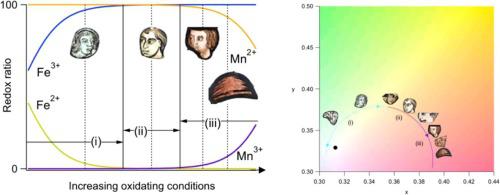Journal of Archaeological Science: Reports Pub Date : 2021-06-17 , DOI: 10.1016/j.jasrep.2021.103082 Natan Capobianco , Myrtille O.J.Y. Hunault , Claudine Loisel , Barbara Trichereau , Fanny Bauchau , Nicolas Trcera , Laurence Galoisy , Georges Calas

|
The present study concerns a corpus of 17 glass pieces representing character heads, originating from 11 major cathedrals and churches from North Western France and which constitute the masterpiece of stained glass windows. Skin complexion ranges from colourless to flesh-tone and purple. These glasses have been investigated using non-destructive and non-invasive techniques. Particle Induced X-ray Emission and Particle Induced Gamma Emission analyses at AGLAE show that these glass pieces show potassic plant ash glass compositions, typical to 12th −15th centuries. The compositional variability of the major glass components remains limited, similar to that found for single monuments, despite the diversity of geographic origins. The Mn and Ba concentrations follow a different trend in flesh-coloured or purple glasses and in colourless glasses, suggesting that the sources of Ba and Mn in these two kinds of glasses originated from different raw materials. Purple and flesh tone glasses contain more manganese than colourless glasses with an almost similar iron content. Synchrotron X-ray absorption near-edge structure spectroscopy (XANES) and portable UV–visible-NIR optical absorption spectroscopy indicate that glass colour varies with results from Fe2+, Fe3+, Mn2+ and Mn3+. The thickness of the glasses, about 3 mm, has been measured using ultrasound techniques. Its dispersion is similar in the various coloured glasses. This parameter mostly influences the colour saturation but not the hue. Obtaining flesh-coloured or purple glasses requires some control of the oxidation state of manganese during glass making. Divalent manganese is largely prevalent and the colour change from flesh-tone to purple hues is driven by small variations in the Mn3+ content. As these variations are not related to the Fe/Mn ratio, the resulting glass colour is difficult to predict on the only basis of glass composition. Due to the low kinetics for obtaining a redox equilibrium state between furnace atmosphere and the silicate melt, using Mn4+- and Mn3+-oxide minerals made it possible to favour oxidized melts, provided the glasses be taken out of the oven before redox equilibrium be reached: the shorter the melting time, the more oxidized will be resulting glass. This shows that medieval glassmakers were able to overcome the challenge of making glasses under highly oxidizing conditions to retaining enough oxidized manganese to favour flesh-tone and purple colours in wood-fuelled furnaces.
中文翻译:

中世纪彩色眼镜中肤色的表现:锰的作用
本研究涉及代表人物头像的 17 块玻璃片的语料库,它们来自法国西北部的 11 座主要大教堂和教堂,构成了彩色玻璃窗的杰作。肤色范围从无色到肉色和紫色。这些眼镜已经使用非破坏性和非侵入性技术进行了研究。AGLAE 的粒子诱导 X 射线发射和粒子诱导伽马发射分析表明,这些玻璃碎片显示出典型的 12 世纪 -15 世纪钾植物灰玻璃成分。尽管地理起源的多样性,主要玻璃成分的成分变化仍然有限,类似于单个纪念碑的成分变化。Mn 和 Ba 浓度在肉色或紫色玻璃和无色玻璃中遵循不同的趋势,表明这两种玻璃中 Ba 和 Mn 的来源不同。紫色和肉色玻璃比无色玻璃含有更多的锰,铁含量几乎相似。同步加速器 X 射线吸收近边结构光谱 (XANES) 和便携式紫外-可见-近红外光吸收光谱表明,玻璃颜色随 Fe 的结果而变化2+、Fe 3+、Mn 2+和Mn 3+。玻璃的厚度约为 3 毫米,已使用超声波技术进行测量。它的分散在各种有色玻璃中是相似的。该参数主要影响色彩饱和度,但不影响色调。获得肉色或紫色玻璃需要在玻璃制造过程中对锰的氧化态进行一些控制。二价锰在很大程度上普遍存在,颜色从肤色变为紫色的原因是 Mn 3+ 的微小变化内容。由于这些变化与 Fe/Mn 比值无关,因此仅根据玻璃成分很难预测最终的玻璃颜色。由于在炉气氛和硅酸盐熔体之间获得氧化还原平衡状态的动力学较低,使用 Mn 4+ - 和 Mn 3+ -氧化物矿物可以有利于氧化熔体,前提是玻璃在氧化还原之前从炉中取出达到平衡:熔化时间越短,生成的玻璃就越氧化。这表明中世纪的玻璃制造商能够克服在高度氧化条件下制造玻璃的挑战,以保留足够的氧化锰,从而在以木材为燃料的熔炉中形成肉色和紫色。









































 京公网安备 11010802027423号
京公网安备 11010802027423号